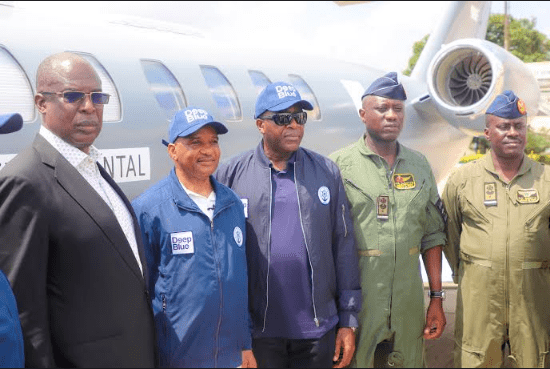
A special mission aircraft was received in Lagos on Wednesday, in the final phase of the delivery and installation of assets under the deep blue project designed to secure Nigerian waters up to the Gulf of Guinea.
The Director General, Nigerian Maritime Administration and Safety Agency (NIMASA), Dr. Bashir Jamoh, received the aircraft, in company with the Minister of State for Petroleum Resources, Timipre Sylva, and NIMASA’s Executive Director, Finance and Administration, Chudi Offodile.
Jamoh had earlier inspected three special mission helicopters at the Naval Base, Apapa, under the project billed for launch on May 21.
Addressing journalists at the Nigerian Air Force Base, Murtala Muhammed International Airport, Ikeja, during a brief ceremony to mark the arrival of the aircraft, Jamoh said the assets would further improve security in Nigerian waters.
He said there will be a drastic reduction in the rate of attacks in the country’s Exclusive Economic Zone (EEZ) with the deployment of the deep blue project assets, saying the goal is to eliminate maritime crimes.
He said, “There has been a drastic decrease in the rate of security breaches in our waters in recent times. This is a clear indication that we are getting it right with the deep blue project.
“The figures we are getting from the International Maritime Bureau (IMB) are encouraging. We ultimately aim to completely eradicate security hindrances to shipping and business generally in the Nigerian maritime domain.”
The integrated national security and waterways protection infrastructure, also known as the deep blue project, is designed with three categories of platforms to tackle maritime security issues on land, sea, and air.
The land assets comprise the command, control, communication, computer, and Intelligence centre (C4i) for intelligence gathering and data collection; 16 armoured vehicles for coastal patrol; and about 600 specially trained troops for interdiction, known as maritime security unit.
On air, there are two special mission aircraft for surveillance of the EEZ, one of which was received Wednesday, with the second expected to arrive on May 18; three special mission helicopters for search and rescue; and four unmanned aerial vehicles.